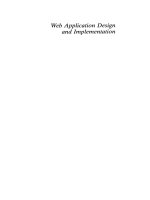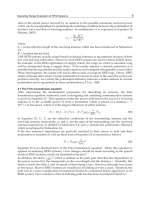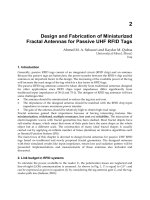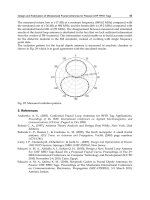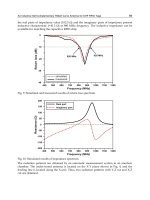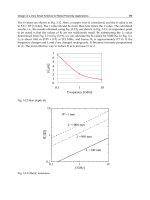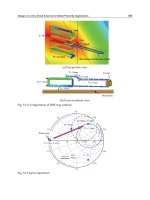web portfolio design and applications
Bạn đang xem bản rút gọn của tài liệu. Xem và tải ngay bản đầy đủ của tài liệu tại đây (9.7 MB, 325 trang )
Web Portfolio Design
and Applications
John DiMarco
St. John’s University, USA, and
New York Institute of Technology, USA
Hershey • London • Melbourne • Singapore
IDEA GROUP PUBLISHING
Acquisitions Editor: Michelle Potter
Development Editor: Kristin Roth
Senior Managing Editor: Amanda Appicello
Managing Editor: Jennifer Neidig
Copy Editor: Jennifer Young
Typesetter: Sharon Berger
Cover Design: Lisa Tosheff
Printed at: Integrated Book Technology
Published in the United States of America by
Idea Group Publishing (an imprint of Idea Group Inc.)
701 E. Chocolate Avenue
Hershey PA 17033
Tel: 717-533-8845
Fax: 717-533-8661
E-mail:
Web site:
and in the United Kingdom by
Idea Group Publishing (an imprint of Idea Group Inc.)
3 Henrietta Street
Covent Garden
London WC2E 8LU
Tel: 44 20 7240 0856
Fax: 44 20 7379 0609
Web site:
Copyright © 2006 by Idea Group Inc. All rights reserved. No part of this book may be reproduced,
stored or distributed in any form or by any means, electronic or mechanical, including photocopying,
without written permission from the publisher.
Product or company names used in this book are for identification purposes only. Inclusion of the
names of the products or companies does not indicate a claim of ownership by IGI of the trademark
or registered trademark.
Library of Congress Cataloging-in-Publication Data
Web portfolio design and applications / John DiMarco, editor.
p. cm.
Summary: "This book defines and gives an overview of the web portfolio and how it is being used in
academic programs and professional scenarios" Provided by publisher.
Includes bibliographical references and index.
ISBN 1-59140-854-7 (hardcover) ISBN 1-59140-855-5 (softcover) ISBN 1-59140-856-3
(ebook)
1. Portfolios in education. 2. Internet in education. 3. World Wide Web. I. DiMarco, John, 1969-
LB1029.P67W43 2006
374.126 dc22
2005023880
British Cataloguing in Publication Data
A Cataloguing in Publication record for this book is available from the British Library.
All work contributed to this book is new, previously-unpublished material. The views expressed in this
book are those of the authors, but not necessarily of the publisher.
Web Portfolio Design
and Applications
Table of Contents
Preface viii
Chapter I. Introduction to the Web Portfolio 1
Introduction 1
Background 2
Web Literature and Review 4
Who Needs a Web Portfolio? 10
Defining the Electronic Portfolio and the Web Portfolio 12
The Web Portfolio as the Preferred Electronic Portfolio 13
Types of Web Portfolios 16
The Web Portfolio Fosters Valuable Learning Experiences 20
Skills Fostered by the Web Portfolio Process 24
The Web Portfolio as an Appearance 25
The Benefits of Web Portfolios 26
What You Should Get Out of This Book 27
Review and Conclusion 31
Chapter II. Conceptualization 32
Introduction 32
Defining the User, Understanding the Audience 33
Define Your User and Their Goals 36
Concept 38
Write Your Concept Statement 41
Content Gathering 41
Text as Content 43
Create Your Content List 44
Create Your Content Outline 45
The Web Portfolio as a Content Management Tool 50
Review and Conclusion 50
Chapter III. Information Design 52
Introduction 52
Structure 53
Web Portfolio Information Organization 54
Flowcharts as Skeletons 54
Navigation 55
Usability 57
Pre-Evaluation of Usability 58
Create Your Flowchart 59
Review and Conclusion 61
Chapter IV. Visual Design 62
Introduction 62
Style 64
Composition and the Web Portfolio 72
Space 73
Type 80
Images and Graphics 81
Metaphors and Image Maps 83
Identity 83
Color Schemes 84
Navigation Systems 84
Backgrounds 85
Pop-Up Windows 86
Storyboards 86
Conclusion 88
Chapter V. Content, Collection, Development and Management 89
Introduction 89
Revisiting the Content Outline 90
Setting Up the Folder Structure 91
Image Types 92
PDF 92
Web Color 94
Size 96
Resolution 97
Using Photography to Develop Content 98
Scanning Your Work 99
vii
Taking Screen Captures 99
Image Preparation, Crop, Scale and Save 100
Text-Based Content 102
Web Resumes and CVs 102
Project Descriptions 103
Review and Conclusion 104
Chapter VI. Web Page Design 105
Introduction 105
Digital Tools 106
Visual Design of Web Screens 108
Pop-Up Windows 109
Text Decisions 110
Icons and Logos 111
Navigation and Buttons 112
A Word About Slicing and Exporting Pages 112
Slicing Pages 115
Optimizing and Exporting Pages and Graphics 116
Review and Conclusion 121
Chapter VII. Web Authoring 122
Introduction 122
WYSIWYG Applications vs. HTML Hand Coding 123
Opening Sliced Web Pages from Fireworks 124
Tables 125
Creating a Web Page Using Macromedia Dreamweaver 127
Layers 130
A Brief Review 137
Links 137
CSS 144
Behaviors 146
Meta Tags and Keywords 153
Review and Conclusion 154
Chapter VIII. Motion, Graphics and Multimedia Production 157
Introduction 157
Overview of Web Multimedia Applications and Design Processes 158
Motion Graphics Defined 159
Basic Concepts in Macromedia Flash 161
Creating the Text Animation 166
Symbol Editor 171
viii
Preparing Audio in Adobe Audition 180
Placing Audio in Flash 185
Making Edits to the Flash Files 191
Conclusion 192
Chapter IX. Uploading and Testing Your Web Portfolio Site 193
Introduction 193
What You Need to Put Your Portfolio on the Web 194
Where You Can Post Your Web Portfolio 196
File Transfer Protocol (FTP) 198
Towards Redesign 206
Conclusion 207
Chapter X. Launch and Promotion 208
Introduction 208
Marketing 209
Review and Conclusion 212
Chapter XI. Server-Side Technologies 213
Introduction 213
PHP 214
Active Server Pages (ASP) 214
ASP.NET 215
CGI 217
Perl 219
ColdFusion 220
Conclusion 221
Chapter XII. Cases and Interviews 222
Introduction 222
Web Portfolio Program Case 223
Sample E-Portfolio Proposal 227
Interviews 244
Interview Conclusion 250
Case Study of Teacher Web Portfolios 250
Review and Conclusion 275
Chapter XIII. Web Portfolios in the Information Society and
Future 277
Introduction 277
The Web Portfolio’s Place in the Information Society 278
The Web Portfolio as Personal, On-Demand, Mass Media and Advertising 279
ix
The Web Portfolio in the “Knowledge Worker Age” 280
The Web Portfolio as the Postmodern Appearance 281
The Web Portfolio as Postmodern Narrative Connection 283
A Web Portfolio Makes You Digital in a Wired World 285
The Web Portfolio as a Personal Knowledge Portal 288
The Web Portfolio as a Responsive Environment 290
Conclusions 291
References 293
About the Authors 299
Index 301
viii
Preface
Rationale
Back in 2002, I spoke at an educational technology conference sponsored by
Syllabus magazine. My topic was Web portfolios for students and instruc-
tors. I proposed the topic out of a desire to feed my own curiosity regarding
the research front. At the time, I was teaching a wide variety of digital art and
design courses. One of my core principles when teaching in the digital medium
is to have learning objectives that direct students toward creating tangible
projects and ultimately harvesting portfolio-level work. It made sense for my
students and for me to have evidence that the material presented in the course
was put into practice, and students needed a dynamic platform to display their
work. To accomplish this, I planned and developed a comprehensive Web
portfolio of student work with over 100 student Web portfolios (unfortunately,
a year later, the university changed over servers and the online sites were
lost). I presented the Web site and explained the process to an audience of
150 technology educators. I opened the cluster session with two questions.
When I asked the first, “How many people in this room are provided free
Web space from their institution?” almost everyone in the room raised their
hand. Then I asked, “How many people are actually taking advantage of it
and using it?” Ten hands rose.
ix
I was shocked. These are technology people! Then I realized that they were
not behind the curve, they were just reaching the point where they wanted to
begin embracing Web portfolio development. That’s when I knew that the
information I was about to provide would have residual value for them and
their students. After further research, I realized that Web portfolio develop-
ment was in its infancy and I needed to devote research efforts into helping
more people embrace the Web portfolio. There are some initiatives in place at
the college level to implement Web portfolios. One such example is LaGuardia
Community College. The school has mandated the development and output of
electronic portfolios for all graduating students. The initiative brought in tech-
nology and specialists to provide the instructional and infrastructure support
that such a project requires. Regardless of mandates, it is the responsibility of
the professional educator to integrate Web portfolios into their pedagogy and
teaching and learning initiatives. Ultimately, the instructor must pass on the
skills and experience in Web portfolio design and development to their stu-
dents.
The Web Portfolio as an Information
Product for Communication
The desire to help people succeed with communication was a major influence
in my decision to dig into Web portfolios as a research initiative. The Web
portfolio is ultimately a platform for communication and the concepts, images,
and messages within the Web portfolio are centered on persuasion, a major
area in communication studies. The Web portfolio takes on the form of an
information product for communication. To develop the information product
properly, you must first analyze, retrieve, categorize, and manage your pro-
fessional data so that it is refined into information. The refined information is
put into a communication context, the Web portfolio. The communication gen-
erated from the Web portfolio is shaped by content, design, visual quality,
usability, and overall experience visiting the site. The communication should
be persuasive with the goal of getting the visitor to act favorably towards the
author, whether consciously or subconsciously. I want this book to serve the
reader as a tool for helping establish the foundation skills and act as a motiva-
tional force.
x
In addition, this book intends to give a well-rounded view of the Web portfo-
lio and how it is being used in academic programs and professional scenarios.
The skills and experience acquired while creating a Web portfolio must be
passed on to others as they begin to explore Web portfolio development.
The Focus and Benefits
In this text, we focus on several areas inside the realm of the Web portfolio:
• The virtues of the Web portfolio;
• The professional software tools needed to create a Web portfolio;
• The important processes that are needed to execute Web portfolio de-
velopment and production;
• Beginner and advanced techniques using multimedia and Web authoring
tools; and
• What electronic/Web portfolios may evolve into as what I call “the
postmodern professional appearance” of the information society.
We will examine brainstorming, design, and development. The process out-
lined in the text takes you through the creation of a Web portfolio. I use ex-
amples from my own Web portfolio and others to illustrate key points about
design and development. The tools and techniques used in this book can be
applied to developing a Web portfolio for a person or an entity in any industry
or position. My infinite hope is that this book becomes a results-driven re-
source for the teaching and learning of Web portfolio development and that
the book becomes a cookbook for getting a Web portfolio created. This will
hopefully result in students and instructors creating Web portfolios. Putting
together a Web portfolio does require some work, but the work is not without
benefits. The learning process that occurs during the Web portfolio design
process will give you skills and experiences with technology, self analysis, and
Web design. When it comes to making the commitment to creating a Web
portfolio, both students and instructors will see tremendous payoffs. For the
instructor, the Web portfolio is not a course Web site. It has the same purpose
as a student portfolio, to persuade. There are other common benefits shared
by students and instructors who create Web portfolios. The Web portfolio
gives the author nine worldwide mediums to freely disseminate professional
information. A Web portfolio offers the creator a cost effective promotional
xi
tool. The Web portfolio also serves as a dynamic hub for communication,
between students, faculty, employers, and academia. The power of multime-
dia applications on the Web such as Macromedia Flash allows a rich multime-
dia environment for presentations and collaboration. The Web portfolio gives
the author an integral advantage in real-world self-promotion. Creating a Web
portfolio shows a tangible technology achievement. The Web portfolio and
subsequent redesigns throughout your career will yield lifelong learning in Web
technology and self promotion. Specifically for instructors, the Web portfolio
can act as a testing ground for experimenting with Web technology for peda-
gogy, exhibition, program, promotion, collaboration, online learning, and
archiving.
Here is a brief overview of each chapter.
• Chapter I — Introduction to the Web Portfolio
This chapter puts the Web portfolio into perspective and describes sev-
eral thoughts supporting the Web portfolio as a communication tool for
lifelong learning that presents a professional appearance. The chapter
explains how the Web portfolio development process is a skill-building
experience that has dynamic benefits.
• Chapter II — Conceptualization
This chapter guides you in developing concepts, images, and messages
needed for the Web portfolio. Content collection and evaluation is dis-
cussed as the Web portfolio is put into the context of a content manage-
ment tool. The chapter gives examples on how to develop the scope
documents needed to organize the Web portfolio. The concept state-
ment, content list, and content outline are explained and exampled. This
chapter represents the first step in the Web portfolio design and devel-
opment process.
• Chapter III — Information Design
This chapter shows you the process of information design for Web port-
folios. You get a chance to display navigation and usability in a functional
flowchart that is based on the concept and content scope documents that
you worked on in Chapter II. The chapter concludes with creation of a
flowchart. This chapter represents the second step in the Web portfolio
design process.
• Chapter IV — Visual Design
This chapter explores the visual aspects of creating attractive well-de-
signed Web pages. Focus is on basic design principles and establishing
xii
ideas on how you want the Web portfolio pages to look. Color, compo-
sition, and typography are explained so that novice designers can be
guided on how to create strong pages. The chapter concludes with in-
struction and development of story boards that represent rough site de-
signs. This chapter represents the third step in the Web portfolio design
process.
• Chapter V — Content, Collection, Development and Management
This chapter provides techniques and strategies for collecting and creat-
ing content from existing assets and project files. The chapter gives ad-
vice on scanning and photography as well as how to use the resume in
the Web portfolio and how to describe projects you present in the Web
portfolio. This chapter represents the fourth step in the Web portfolio
design process.
• Chapter VI — Web Page Design
This chapter introduces digital tools in the design of Web page screens
and graphics. Discussion includes design of buttons, navigation, and pop-
up windows. Coverage includes slicing, optimizing, and exporting Web
pages. An easy to use workflow is presented that allows rapid develop-
ment of Web pages using visual tools instead of handwritten code. This
chapter represents the fifth step in the Web portfolio design process.
• Chapter VII — Web Authoring
This chapter introduces Web page authoring tools and provides tutorials
and workflows for using Macromedia Dreamweaver. Major Web func-
tionality issues are covered and appropriate techniques are explained.
The chapter goal is to get the Web portfolio to a stage of functionality.
This chapter moves you toward a working Web portfolio.
• Chapter VIII — Motion, Graphics and Multimedia Production
This chapter provides discussion and instruction on using Macromedia
Flash for multimedia production and Adobe Audition for audio editing.
The tutorials shown guide you in developing essential multimedia com-
ponents that can be integrated into the Web portfolio seamlessly. Cover-
age includes creating text animation and using audio tracks in Web pages
with Macromedia Flash.
• Chapter IX — Uploading and Testing Your Web Portfolio Site
This chapter provides the last technical step to getting the Web portfolio
up on the Internet. Coverage spans the Internet and FTP and discusses
how to use Macromedia Dreamweaver for uploading, downloading, and
managing site files. The theories of Molich and Nielsen are presented in
the context of Web portfolio usability. The chapter ends with discussion
on redesign and the commitment to continual improvement and content
flow in the Web portfolio.
• Chapter X — Launch and Promotion
Getting the Web portfolio launched and marketed is the topic of this
chapter. The Web portfolio marketing process involves traditional and
electronic media to be effective. The chapter provides some marketing
ideas that can be used in a comprehensive launch plan or individually for
small scale promotions.
• Chapter XI — Server-Side Technologies
This chapter provides the last technical data on server-side technologies
and discusses dynamic integration into the Web portfolio. Coverage in-
cludes ASP, ASP.net, Coldfusion, PHP, and CGI/Perl. The chapter is
intended to give an overview of the technologies and some technical in-
formation on versions and updates. I try to provide the latest data, but
data is obsolete quickly after deployment when it comes to application
technology.
• Chapter XII — Cases and Interviews
This chapter discusses cases and shares interviews that describe Web
portfolio challenges and successes. The focus is on exploring different
approaches to Web portfolio development in order to illustrate that there
is no one defined way to make a Web portfolio. Creating Web portfolios
and Web portfolio programs is a subjective process that centers on the
needs and goals of the authors. This chapter provides interviews with
educators and applies possible characteristic criteria to Web portfolios
across disciplines.
• Chapter XIII — Web Portfolios in the Information Society and
Future
This chapter focuses on theoretical examination of the Web portfolio in
the knowledge worker age and the information society. Theorists’ views
are synthesized into my theory on the future of the Web portfolio. As
technology flattens the world and masses of people continue to get digi-
tal for multitude of reasons, the Web portfolio will become a vehicle for
responsive communication and connection to the world of work for hire.
This chapter concludes the book and I hope it provides food for thought
as you continue your expedition toward making Web portfolios a staple
part of your public existence. As well, I hope to encourage further re-
search on Web portfolios from scholars across disciplines.
xiii
Conclusion
During my literature review over the past two years, I noticed that there are
no comprehensive textbooks that describe the Web portfolio from a process
centered approach and a theoretical approach. Most books describe the Web
portfolio in the context of the K-12 teacher and give descriptive instruction on
artifact evaluation and standards based development. This makes sense due
to the standardization of the Web portfolio into the curriculum of education
departments worldwide. I refer to and quote education based portfolio devel-
opment texts throughout this book. The clarity of explanation that the educa-
tion field has developed in the promotion of Web portfolios is exceptional. I
could not provide only the views of educators because I wanted the focus of
this book to give a wide angle view of Web portfolios. So, I begin the book
by describing the Web portfolio and the critical skills and benefits you get
when making one. Then, I discuss concepts and content. Next, I provide a
quick study of the important design principles needed to create a Web portfo-
lio that has visual presence and shows your work in the best composition
possible. Then, focusing on Macromedia tools, I give you professional level
tutorials to help you begin the software engagement that you will need to be
confident and active in Web portfolio design and development. I provide some
thoughts on uploading and launching and lastly there are a wealth of cases and
interviews to build your exposure to options for instituting a Web portfolio
program in your institution. By taking a pan disciplinary approach to the Web
portfolio and its components, I hope to enable you to build your own thoughts
and realize your own success with Web portfolios within your institution, your
pedagogy, your career, and your life.
I encourage scholars and students to work toward advanced research in Web
portfolio development that goes beyond technical situations and software ap-
plications to dissect the interactions and behaviors that play a role in Web
portfolio development, ownership, and presentations.
Please enjoy this book and the journey into the world of Web portfolios.
xiv
Acknowledgments
xv
It takes many people to produce a book. I would like to gratefully acknowl-
edge the people who contributed to this project. My appreciation extends to
many different groups who were instrumental in helping me to stay the course
and overcome the mental, physical, and organizational challenges that exist
within any extensive project.
I want to thank the extraordinary staff at Idea Group, Inc. for supporting this
project from conception to completion. Dr. Mehdi Khosrow-Pour, Renée
Davies, Jan Travers, Amanda Appicello, Jennifer Neidig, and Kristin Roth
provided me with the guidance to transform my concepts, processes, and
research into this book. Throughout the development process, the team at
Idea Group worked with me to find and communicate my vision for the Web
portfolio and its future in society.
Next, I want to thank my colleagues at Canon, USA, Paul Balsamo and Mitch
Bardwell, who graciously supported my scholarly endeavors for the past two
years. I am especially thankful for the thoughtfulness shown to me by Paul
Balsamo. Paul’s propensity towards being a mentor, teacher, and a friend
cannot be denied, and those qualities have made many of my interactions with
him valuable learning experiences. Other people in my professional life who
helped me with this book and career and need to be thanked are my sincere
friends John Fekner and Rick Mills. I also need to thank Dr. Frank Brady for
his mentoring and help. Lastly, in the professional category, I am appreciative
to the Information Studies Doctoral Program faculty members at Long Island
University who were my professors this year. Dr. Hildreth, Dr. Chu, Dr.
Spaulding, and Dr. Smiraglia taught me research methods and exposed me to
theories that I applied in writing this text.
I want to gratefully acknowledge my family and friends who are truly the most
important part of my life. To Steve and Debbie, and Joey and Laura, thanks
for being the greatest friends Kim and I could have. Mr. Lawrence, Paulie,
Ginger, Brianna, Tori, and Justin have become my immediate family and I am
grateful that I have them in my life. I also want to thank the Borowski family
and Mrs. Florence Borowski for making me part of the whole family and for
giving me the competitive and social outlets I need to have fun and enjoy life.
Stolat!
On the Arizona side of my heart, sincere thanks to my family; I miss and love
you all very much! Thanks to my parents, John and Frances DiMarco, for
giving me the opportunities to explore life and the strength to embrace chal-
lenges. Thanks to my lovely sister Roseann and her family, my dear niece Gina
and her new husband Richard, Corinne, and their boys Tristan and Ricky.
And, thanks to my sister Margaret and the Marino family: Jerry, Alexis, and
Joey – for always being there for us.
I must thank the people who contributed to the writing of this book. David
Power contributed to the research and writing of the chapter on server-side
technologies. Thanks, Dave, for the help with the book and for becoming a
good friend. You have made my experiences at Canon and on the golf course
special with your humor, kindness, and insight. Finally on the topic of help
with the book, I must acknowledge Kimberly DiMarco, my wife, who con-
tributed to the chapter on cases and interviews and provided editing and or-
ganizational help throughout the manuscript development.
The most important person to me in this world is my wife Kimberly. She truly
is my partner, my love, and my life. So, sweetie, thank you for enduring and
contributing to this project. Thanks for giving me the support to go for it. And,
thanks for working hard to take care of Molly, Emma, and me.
This book is dedicated to the memory of Karen Lawrence. We all miss you
and love you.
John DiMarco
xvi
Introduction to the Web Portfolio 1
Copyright © 2006, Idea Group Inc. Copying or distributing in print or electronic forms without written
permission of Idea Group Inc. is prohibited.
Chapter I
Introduction to the
Web Portfolio
Introduction
This chapter introduces the concept of the portfolio and defines the electronic
portfolio and Web portfolio. In print, electronic form, and through the Web, the
portfolio has become a standard tool for success in many disciplines. In the
future, the Web portfolio will be part of the success of people in all disciplines,
not just those who traditionally utilize portfolios, such as artists and teachers.
The chapter frames the Web portfolio as a tool for persuasion and lifelong
learning. I introduce many different concepts, cases, and relevant information
from literature and Web reviews. I want to stimulate your ideas about the Web
portfolio so I provide some interesting uses of the Web portfolio within
academic settings.
The objectives of the chapter are to define the electronic portfolio and its most
utilized format, the Web portfolio. Discussion will focus on how the Web
portfolio benefits those who explore its creation. Finally, I explain what to
expect from the rest of this text.
2 DiMarco
Copyright © 2006, Idea Group Inc. Copying or distributing in print or electronic forms without written
permission of Idea Group Inc. is prohibited.
Background
Goldsby and Fazal (2001) cited that student created portfolios are commonly
“used in teacher preparation programs to demonstrate teaching skills and
expertise. This practice was introduced as test scores alone lack the compre-
hensive scope needed for effective assessment and evaluation, portfolios can
be implemented to interpret/make decisions regarding learning of teaching
competencies” (pp. 607-608). The case for the student portfolio in any
discipline can be made on the same basis; electronic portfolios provide a new
level of assessment that cannot be measured by traditional methods such as
standardized tests, applications, and resumes. Electronic portfolios and Web
portfolios provide assessment of competency within a discipline.
The old models of professional and personal identity, skills assessment, and
promotion are fading in what Dr. Stephen Covey (2004) describes as the age
of the knowledge worker. In the knowledge worker age, the focus is on
intellectual capital and exhibiting the skills of someone who is technologically
savvy, but sensitive to the vision and voice of traditional values that enable
people to thrive, such as mentoring. The Web portfolio feeds the emergence of
intellectual capital by providing a platform for the knowledge worker to exhibit
their personal and professional qualities. Mentoring will be increased as the
Web portfolio becomes a standard learning tool within mainstream education
at all levels. Teachers will need to teach students how to make Web portfolios.
In turn, these students will later become mentors to others in their lives who are
creating Web portfolios. Electronic portfolios and Web portfolios feed the
process of lifelong learning.
Educators on all levels need to embrace the Web portfolio as a tool, regardless
of their discipline. As a tool, it should be mastered by teachers and taught to
students within the appropriate contexts of their disciplines. If a student creates
an art portfolio, it has a structure and presentation style that will focus on the
artwork and the skills of the artist. If the portfolio is for a student in the discipline
of English, the portfolio should focus on the writings and literature aptitude of
the creator. In his personal case study on Web-based portfolios for technology
education, Professor Mark E. Sanders (2000) states that:
“The information age is not just a cliché-we’re living it! Global networked
information systems such as the World Wide Web are changing nearly every
aspect of our lives. These technologies should be prominent within our
curriculum. Often, they are not. Web-based portfolios offer a meaningful way
Introduction to the Web Portfolio 3
Copyright © 2006, Idea Group Inc. Copying or distributing in print or electronic forms without written
permission of Idea Group Inc. is prohibited.
for technology students to gain a thorough understanding of these critical new
technologies beyond mere Web research. Web-based portfolios provide
benefits that can never be realized with conventional portfolios” (p.11).
To follow up Professor Sander’s statement, it is critical for all instructors and
students to embrace Web portfolio exploration, creation, and development not
only in technology and education driven disciplines, but also in all disciplines.
The Web portfolio is growing well beyond the boundaries of education and
technology fields and is finding its way outside of educational institutions and
into human resources and other corporate directions. This idea is supported by
Moonen and Tulner (2004) who reported:
But also beyond regular education, interest in electronic portfolio
is growing. EIfEL that commencing in May 2004, EIfEL
(European Institute for E-Learning) is going to provide all of its
Members with an electronic portfolio, the most innovative and
fastest growing technology in the field of education, training
and human resource development. While most current ePortfolio
initiatives happen in primary, secondary, and higher education,
the full potential of ePortfolios will be demonstrated through
lifelong learning. ‘The ePortfolio will be central to support
EIfEL’s members’ continuing professional development, and
the provision of certificates of competence to education, training,
learning and human resource development professionals. Those
certificates will cover all the activities involved in individual,
organizational and community learning, as defined in the forward
looking learning standards of competence developed by EIfEL.
(p. 7)
This quote and the commitment to Web portfolios from the European Institute
for E-Learning is a prime example of the initiation of Web portfolios outside of
academia and into the information society and prophesies the eventual trickling
of Web portfolios into mainstream society. With this in mind, the Web portfolio
should be viewed as a new medium for human persuasion, promotion, assess-
ment, and communication. The e-portfolio is finding application in business.
Carliner (2005) suggests that portfolios are to be used for job seeking or
developmental purposes. This is extremely important in creative fields, techni-
cal fields, and education. These fields have designated electronic portfolios as
4 DiMarco
Copyright © 2006, Idea Group Inc. Copying or distributing in print or electronic forms without written
permission of Idea Group Inc. is prohibited.
mandatory tools for learning, assessment, and presentation. A portfolio carries
or contains something of value. The metaphor is the professional value of the
person or organization. Portfolios historically have carried meanings rooted to
finance or art. Clients of financial firms hold portfolios of securities. Artists have
sheet bound and loose content portfolios which play a duel role as containers
and presentation platforms for their artwork. Now, in the information society,
new portfolios have spawned called e-portfolios or electronic portfolios. E-
portfolio or electronic portfolio encompasses several application specific
portfolios called Web portfolio, teacher portfolio, and digital portfolio (all are
considered e-portfolios). Individuals, teachers, academics, and businesses can
effectively utilize e-portfolios. The definitions vary by scholar and context, but
the purpose for all electronic portfolios is the same, to persuade the user.
Web Literature and Review
This book project has evolved over years of research, development, and
practice. The references section includes monographs as well as Web re-
sources that will give a view of the wide range of data referred to during the
development of this text. In this section, I would like to discuss some Web data
I found that is particularly relevant to helping you understand the Web portfolio
process. The Web portfolio process is a subjective process with varying
objective guidelines which are particular to discipline, that drive the creative
activity of developing a Web portfolio.
One thing that all academic research and publishing projects have in common
is that the information that they are based drives and supports the project is
emergent. The data surrounding electronic and Web portfolios is evolving at
rapid speeds which cause researchers to search for patterns over time. One
pattern is evident, more and more institutions and people are embracing
electronic portfolio on the World Wide Web. A search for Web portfolios on
Google turned up some interesting cases that focused on academia and
commerce. This growth is found not only in academia as you might expect, but
also in business, especially human resource development. There are numerous
companies selling Web portfolios to executives, job seekers, and academics.
The trend will obviously continue as the world becomes flatter and masses of
people worldwide “become digital”. Human resource departments are geared
to rely more and more on Web portfolios to provide a clearer picture of an
Introduction to the Web Portfolio 5
Copyright © 2006, Idea Group Inc. Copying or distributing in print or electronic forms without written
permission of Idea Group Inc. is prohibited.
applicant or a vendor. The Web portfolio will provide a professional appear-
ance for job seekers and companies looking to engage in business.
As I sorted through hundreds of portfolios, my general observations included
many poorly designed Web portfolios that were content abundant. I also found
that the processes in place for asset collection were dominant in most Web
portfolio sites in both academic and business categories. I found many sites
providing recommendations on what a Web portfolio should be. Reflection on
accomplishments was also a central theme common to Web portfolio develop-
ment recommendations. Design of Web portfolio sites was only discussed at
academic or business Web resource sites that catered to target markets or
audiences of students who were artists, designers, and photographers. That is
what I find interesting; the artists who have design training are getting the design
directions while the people who are not formally trained in art and design are
getting most of their help in content collection. In response to that problem
statement, I try to cover all of these bases in this book to help with the major
stages of Web portfolio development and to provide a broad overview of many
approaches and techniques associated with successfully creating a Web
portfolio that fits your specific needs and goals. Let us look at some different
approaches to Web portfolio programs and activities found on the Web.
Google’s 4,550,000 hits revealed to me that the Web portfolio is becoming an
enigma that has evolved into a trend which will gain momentum and become
common practice in academia, professional, and personal environments. Web
portfolios are integrated in society on infant levels in many disciplines; however
activities on the Web reveal a wealth a valuable resources and programs that
need to be discussed in this text. Here are few interesting ideas and approaches
that illustrate why Web portfolios are important as vehicles for lifelong learning,
assessment, and marketability and how they are challenging students and
faculty to respond to the demands of societal Web portfolio integration.
Lifelong Learning
On its Web site, I found that Wofford College in South Carolina has developed
a sound student Web portfolio program centered on developing a timeline of
activities that align with the students’ academic life span at the college. The
development process outlined on the Wofford Web site gives students guided
approaches to content development for academic, personal, and professional
categories that span over freshman, sophomore, junior, and senior years. The
6 DiMarco
Copyright © 2006, Idea Group Inc. Copying or distributing in print or electronic forms without written
permission of Idea Group Inc. is prohibited.
Web portfolio is presented metaphorically as two components: a file cabinet
and a briefcase, the file cabinet being a place for storage of work and the
briefcase being a place for presentation of work. The program neatly breaks
down a timeline of activities for the students to help them keep on track with
the Web portfolio development process through their college career. In
addition, the process makes the student practice Web portfolio development
activities from their freshmen year, it does not assume that Web portfolio skills
are need only in junior and senior years. I found this approach very thoughtful
in helping students succeed because it takes the somewhat takes the respon-
sibility out the students hands and transfers it to the university in making the
student portfolio an institutional learning objective with measurable outcomes.
Assessment
The portfolio has become a premier tool for assessment. Outcomes assess-
ments provide tangible evidence of student growth and learning. Many univer-
sities have adopted Web portfolio programs for the purpose of assessment.
Although the benefits of Web portfolios reach far beyond assessment, this use
is a good one because it forces people to embrace the use of Web portfolios.
One such example is found at the University of Wisconsin Eau Claire. Found
on a page governed by academic affairs and the provost, the university has in
effect a policy document that outlines and is titled “Plan for Assessment of
Student Academic Achievement, Baccalaureate Portfolio Project”. This project
requires students to publish a Web portfolio consisting of 12 of their best
papers for projects completed during their coursework at the college. The
school must have realized that creating Web portfolios might be a tough sell to
students. Although the Web portfolios will benefit the students greatly in the
future, they may be perceived as extra work. So the clever program adminis-
trator added this statement to the academic policy: “Except for completing a
brief cover sheet for each submission, and then uploading the paper to your
Web portfolio, you do nothing in addition to your regular course work.” I was
amused by that statement and a bit concerned. The importance of content in the
Web portfolio must go beyond a dozen artifacts. However, the university in the
Web page states that the Web portfolio is beneficial. The premise of the
benefits are based on the fact that more and more employers and graduate
schools expect graduates to present more than transcripts and letters of
recommendation; they often want to see specific examples of what you have
Introduction to the Web Portfolio 7
Copyright © 2006, Idea Group Inc. Copying or distributing in print or electronic forms without written
permission of Idea Group Inc. is prohibited.
learned and learned how to do. They add that “keeping a portfolio also allows
you to monitor your progress and development at UW-Eau Claire. You will be
able to look back over your academic work and literally see your growth and
learning”.
The benefits of the Web portfolio need to be promoted before making students
feel at ease. A portfolio must be looked at as something of value for the student
not just another assignment to be completed for a course grade. However, the
university senate created an action in 2001 that has required students to
participate in some sort of assessment which may include “interviews, focus
groups, surveys, or portfolios”. The University of Wisconsin provides a good
example of how Web portfolios have been mandated in education. Eventually,
Web portfolios will be mandated as tools for success in society. The level of
assessment will go beyond academia and deep into all professions.
Marketability
The arts have embraced portfolios forever. The ability to show a collection of
work is critical in selling artwork to others. In today’s highly specialized, highly
competitive professional marketplace, more artists are embracing digital
portfolios in addition to high resolution print portfolios. One such field is
architecture. At the University of California Berkeley, the architecture depart-
ment provides a specialized portfolio class in which students learn about
creating digital portfolios and all of their different media components which
include print, video, and Web. The course description has a paragraph that
does more than define the coursework; it also defines the inevitable place of the
Web portfolio in commerce or professionals, not just those within the arts. This
statement gives the indication of the portfolio in general migrating solely from
the hands of artists into the hands of all specialized and non specialized
professionals. The use of Web portfolios will eventually trickle down to
nonprofessional levels.
The UC Berkeley architecture portfolio course description reads: “While the
printed portfolio conveys high-resolution graphical information, today’s de-
signer needs more than paper and vellum to sell their ideas.” CAD models,
digital photographs, video animations, GIS databases, and other multimedia
files are now readily exchanged over the Web. To be competitive, architecture
students must adapt their printed portfolios to incorporate these new media.
This Arch 198 group-study explores the integration of print, video, and Web
8 DiMarco
Copyright © 2006, Idea Group Inc. Copying or distributing in print or electronic forms without written
permission of Idea Group Inc. is prohibited.
media into a coherent and marketable whole.”
This description can be adapted to fit any professional discipline. The central
idea which is critical here is that students must begin to explore the “integration
of print, video, and Web into a coherent and marketable whole”. The
integration of assets into a coherent professional narrative is a critical process
that must be taught and practiced. The importance of the success of the Web
portfolio is evident when the ultimate deliverable is truly marketability. The
Web portfolio gives you marketability.
Enhancing Professional Techniques
We see the use of Web portfolios in every aspect of education. At the 2004
California State University Technology and Persons with Disabilities Confer-
ence, Birnbaum and Kritikos (2004) described how Web portfolios are used
in special education in several capacities. First, they are used by special needs
students and secondly they are used by special education teachers. In the case
of special education, the Web portfolio becomes a place for artifact collection
and management. This is consistent with the idea that the Web portfolio acts as
a portable storage and presentation platform regardless of industry specializa-
tion. This is supported by Birnbaum and Kritikos (2004):
With few exceptions, students with disabilities can learn to
develop Web portfolios as a means of reviewing and
understanding their work. The Web portfolio is an excellent
means of teaching computer skills to these students. Also, it
helps keep track of student progress in an orderly manner. Web
portfolios can be used in IEP meetings so the teacher can
demonstrate student progress in all areas. These portfolios
become legal documents that can be used should due process or
court action become necessary. The use of Web portfolios also
is acceptable to most states’ boards of education. In fact,
several states encourage their use. (p.1)
The application of Web portfolios in special education provides strong evi-
dence the Web portfolio is a tool for developing tangible working knowledge
and skills. It has now been added to the toolset of the special educator and is
not only a viable platform for displaying teachers’ credentials but also has

